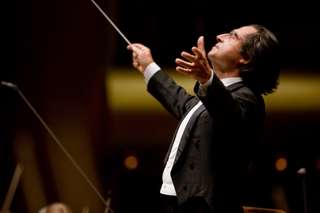|
Back
Orchestral Incandescence New York
Avery Fisher Hall, Lincoln Center
11/19/2009 - & November 20 (Philadelphia), 21 (Washington), 24 (New York)
Franz Liszt: Les Préludes, Symphonic poem after Lamartine
Sir Edward Elgar: In the South (Alassio), Concert-Overture for Orchestra, Opus 50
Sergei Prokofiev: Ten excerpts from Romeo and Juliet, Opus 64
New York Philharmonic Orchestra, Ricccardo Muti (Conductor)

R. Muti (© Chris Lee)
A few hours before this concert, I was asked how conductors can make a difference, since orchestral players are so involved in their music. My answer now is in three phrases: “Riccardo Muti” “New York Philharmonic” “November 19, 2009”
This was a rare purely orchestral mainstream concert. Maestro Muti had no contention with soloists, no discombobulating atonalism. His three works were colorful, relatively familiar, painted with fire and ice. Put another way, the Maestro had a gigantic easel, every pigment he desired, and the personal genius to splash or sculpt whatever pictures he could imagine. Lesser souls (in other words, most other conductors) might have played to the rafters, but Mr. Muti made no attempt to drive his orchestra with supposed Italianate fury.
The ultra-popular Liszt Préludes is far more poetic than bombastic but we have all heard conductors rushing around the development to reach the crowd-pleasing final fanfares. Not Mr. Muti. The tension of the opening was palpable, that fanfare first theme was brassy enough. But then Mr. Muti took a different tone.
He was not afraid to take the “Wind” cello theme (the only uninteresting part of the work) far slower than usual. But the tempo was not ill-judged by his standards, for he could take a more spacious view of the pastorale episode, bringing out the gorgeous harp arpeggios. No conductor can avoid the parodistic timpani echoes of the strings, but Mr. Muti took his time for the “great” final measures.
Again, a change of pace. Lamartine called death’s trumpet call the prelude to a final hymn, not a battle. Mr. Muti played it as a hymn, as a spacious prelude to another life, not a war to defeat the enemies.
The second work. Elgar’s hypocritical tribute to Italy–he hated the place, the weather was terrible, his proposed Italian “symphony” was truncated into a mere concert-overture–is also one of my favorite Elgar pieces. Yes, it has the usual Elgarian energy, it employs, correctly, his favorite direction, Nobilmente for a very noble episode.
But instead of going on a a sunny pace, Elgar brings forth an architectural structure beginning in the bass which is impressive as any Roman structure. Had Respighi ever written “The Bridges of Rome”, he would have been hard-pressed to find something so dramatically real.
Mr. Muti never pushed the orchestra, but they worked with splendid Mediterranean color.
Yet if I could choose only a few musical minutes to show what a conductor can do, it would be the balcony scene from the Romeo and Juliet excerpts. (Essentially the First Suite, plus “Friar Laurence” and the death scenes.)
Mr. Muti was dynamic enough in the preceding scenes, pompously accenting the “Minuet”, offering a sprightly flute solo in “Madrigals”. But in the “Balcony Scene”, Mr. Muti pulled–with arms, with body, with fierce tension–the most luscious string sounds I’ve heard from the Phil this year.
Only a churl, in fact, would have mentioned the reality of a rainstorm on this resplendent evening, for Mr. Muti’s moonlight was so memorably pervasively poetic.
Harry Rolnick
|